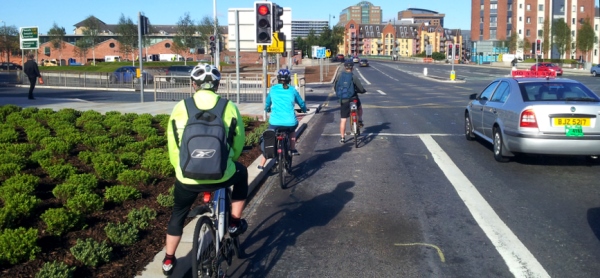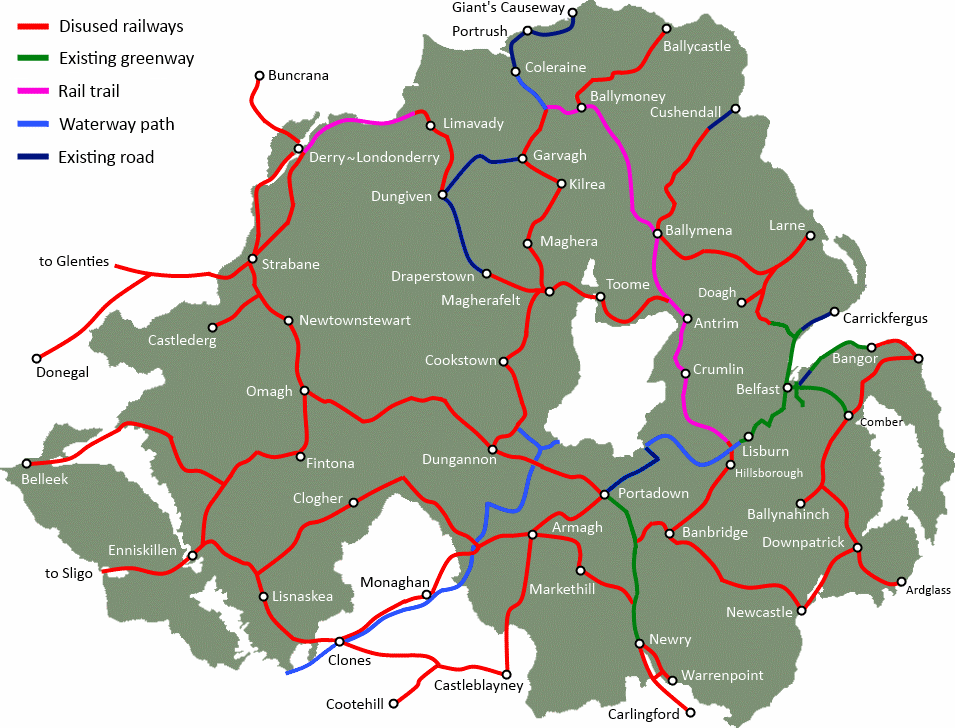Recently, the Belfast bin lane (cycle lane on Upper Arthur Street) has seen the return of the red Biffa bin. Following contact with the company last September, partial success has been observed – it’s mostly been the Aisling award winning Wastebeater bins blocking the cycle lane of late.
Biffa’s explanation this time is that neither Biffa nor their client businesses are responsible for blocking the cycle lane. A mysterious unseen force is at work! Sensing Biffa trying to cover their behinds in the face of evidence showing blatant obstructions, NI Greenways allows poor Biffa enough rope to hang themselves..
Oh dear, empty @biffa_uk bin blocking cycle lane on Upper Arthur St Belfast this morning #binlane twitter.com/nigreenways/st…
— NI Greenways (@nigreenways) May 7, 2013
– May 7 – (same morning)
Biffa
According to our Traffic Dispatcher at the depot, he has spoken with the driver who does this round. The driver has assured us that when he gets to the bin it is already in the cycle lane and after he empties it he sets it back against the wall. This afternoon our depot spoke to the manager of the Basement bar and explained the situation, he has told us that they always leave the bin up against the wall when they put it out in the morning. Given that both the manager of the bar and our driver are both insisting that they leave the bin against the wall, it must be being moved by a third party. If we could obtain CCTV we’d know for certain. Unfortunately, all we can do for now is move the bin back every time we discover it relocated. Happy to work with you if you have any other suggestions.
>>Bullshit alert!<<
– May 7 –
NI Greenways
Really appreciate you getting back so quickly.
Can I clarify exactly what you’re saying in your email, perhaps easiest if we refer to the attached picture?

The Basement staff and Biffa staff are leaving the red Biffa bin by the wall (marked GOOD) but some unknown third party is moving them to the cycle lane (marked BAD, Wastebeater bin as example). Is this correct?
– May 7 –
Biffa
This appears to be the case. As I said, we are happy to work with you on a solution, if one can be found.
– May 8 –
NI Greenways
Thanks for the clarification. The solution is very obvious when we summarise the situation as you lay it out:
- Basement staff are leaving the Biffa bin out for collection on the pavement, obstructing the public footpath
- Some mysterious third party is then moving the bin to obstruct the cycle lane
- Biffa staff collect the refuse and return the bin to its position obstructing the footpath
- Again a third party then removes the bin to obstruct the cycle lane
- Basement staff (at some point) take the bin back into the alleyway
So, whether or not some pesky unseen hand is taking the Biffa bin into the cycle lane, you’ve been very clear that both Basement staff and Biffa staff are placing the bin in a position which restricts pedestrian use of the footpath. If this is reported to Roads Service, the bin could be removed. This could leave the Basement liable to a return fee, and could jeopardise your client relationship. Never mind the grubby corporate image for Biffa of a branded bin blocking a city centre footpath/cycle lane and causing great inconvenience for wheelchair users among others.
You can see a few examples here, no doubt all caused by some third party:
http://www.flickr.com/groups/2191227@N22/pool/
The solution is very simple. Bins should be left at, and returned to, the alleyway. I look forward to your reply
– May 8 –
Biffa
Many thanks for your suggestion. I’ll speak to the depot and find out whether this is possible. I imagine from our point of view, it makes no difference if the bin is located in the alleyway. However, I’m based in Birmingham and not familiar with this area. By leaving the bin in the alleyway it may be obstructing delivery/emergency vehicles or there may be some other reason. I’ll check with the depot and let you know.
– May 8 –
Biffa
I’ve spoken to the depot. They will ask the driver to pull the bin the 100 yards up the alley way back to the basement bar after it has been emptied. If its left in the entry to the alley way it’ll block access to a garage, which may explain the third party issue. Hopefully this will resolve the issue.
… … … … … … … … … … … … … … … … …
Give credit to Biffa for another speedy response and, at the point of complaint, a willingness to engage. Also thanks to DRD, who are keen to hear about bins blocking this cycle lane, and will happily remove offending items if reported.
The entry only being 30 yards long isn’t quite the chore it’s made out to be (and yes, even Google Maps Streetview loves a bit of bin lane blocking #facepalm). It’s also a daft suggestion that a bin set against a wall on a footpath would be moved by a car driver trying to get down the alleyway, but then the bin lane does have it’s own special rules and perhaps laws of physics, so anything’s possible.
Whether the spooky third party movement excuse was a spectacular porky or not, at least it cleared up that Biffa bins shouldn’t be blocking the pavement or the cycle lane. And they won’t be in the future. Will they? Oh Biffa..
– 3 June –
More bin lane love:
Report an obstruction on a footpath, cycle lane or road on the NI Direct site
Follow the latest blockages on the Belfast Bin Lane Flickr group (sad as it is)
Is it still the bin lane or is it the Ulster Bank delivery lane?
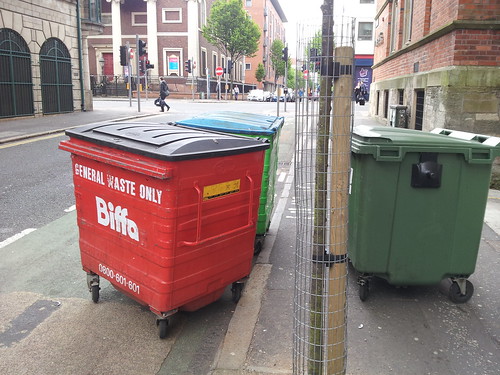
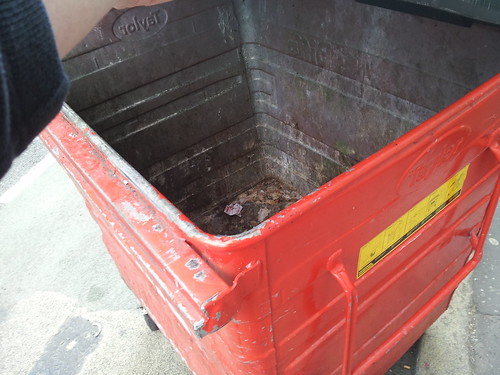
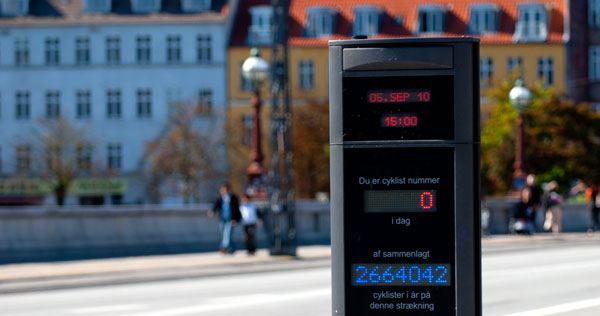
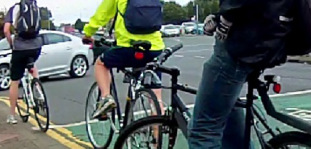 But instead of being deterred, we need to organise and innovate! Since I started blogging about Belfast cycling I’ve seen amazing resourcefulness and passion among local people who choose to get around by bike. New community connections are being built every day, and spawning innovative action such as Reclaim Belfast’s Cycle Lanes 1 and 2. It is among the people who ride our streets every day that we will find creative solutions to change the experience and perception of cycling here.
But instead of being deterred, we need to organise and innovate! Since I started blogging about Belfast cycling I’ve seen amazing resourcefulness and passion among local people who choose to get around by bike. New community connections are being built every day, and spawning innovative action such as Reclaim Belfast’s Cycle Lanes 1 and 2. It is among the people who ride our streets every day that we will find creative solutions to change the experience and perception of cycling here.